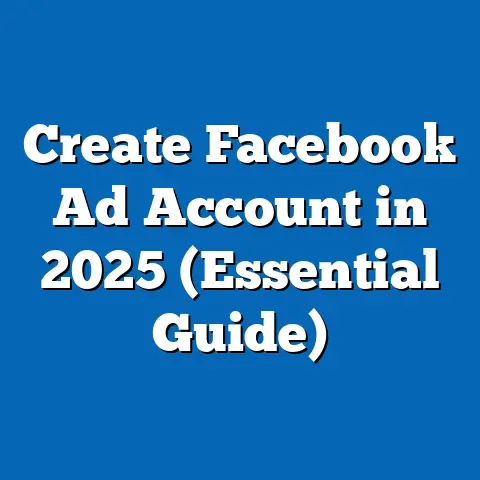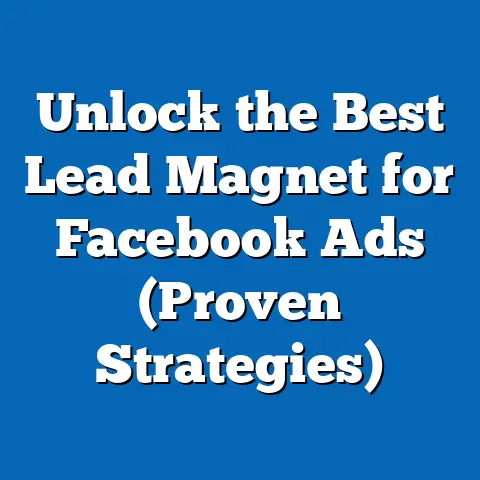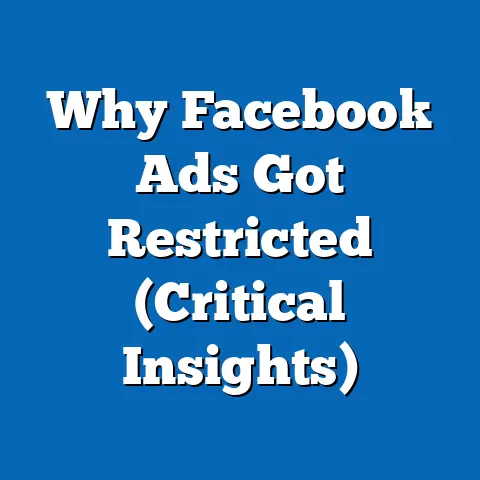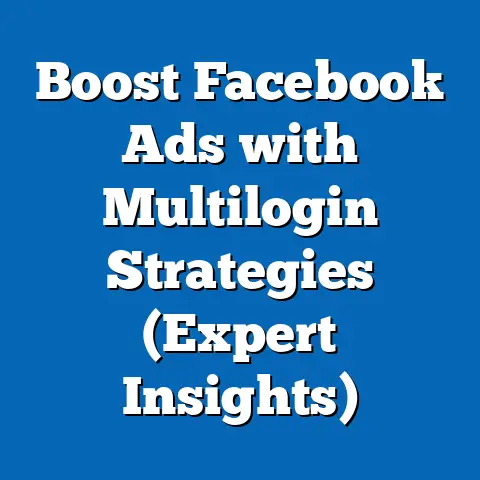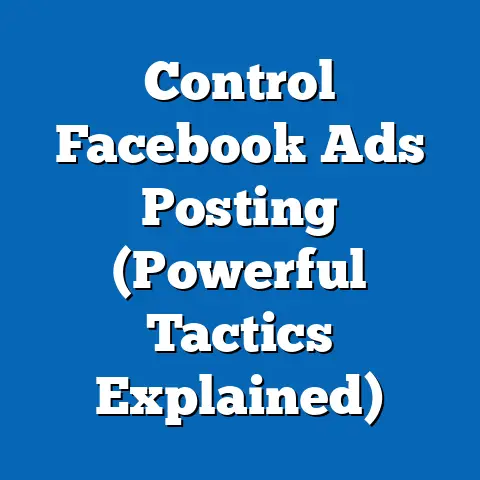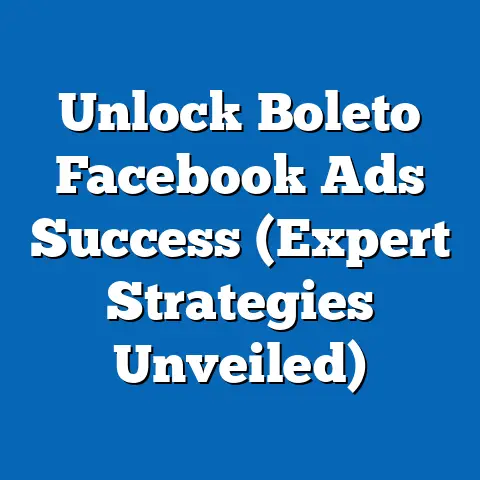Revamp Facebook Ads for Musicians (Pro Strategies Revealed)
As the chilly autumn air sweeps through, swirling fallen leaves into ephemeral dances, I find myself reflecting on the ever-changing landscape of the music industry. Just as nature prepares for a season of rest, musicians, too, must constantly adapt and evolve their strategies to stay relevant and thrive. In today’s digital age, one of the most powerful tools in a musician’s arsenal is Facebook advertising. It’s no longer enough to simply create great music; you need to connect with your audience where they spend their time, and for millions, that’s on Facebook. This guide will delve into the pro strategies that can help musicians revamp their Facebook ads and amplify their reach in a crowded marketplace.
The Importance of Facebook Ads for Musicians
Facebook offers a unique and unparalleled opportunity for musicians to connect with potential fans. Think about it: Facebook boasts billions of active users each month, a vast ocean of potential listeners just waiting to discover your music. It’s not just about the sheer numbers; it’s about the platform’s ability to hyper-target specific demographics.
I remember when I first started working with local bands, many were skeptical about the power of digital advertising. They thought word-of-mouth and playing local gigs were enough. While those things are still important, they are no longer sufficient in a world where attention spans are shrinking, and competition is fierce. Facebook ads allow you to break through the noise and get your music in front of the right ears.
Consider these statistics: Facebook’s ad reach is immense, and engagement rates on music-related content can be surprisingly high. This isn’t just about vanity metrics like likes and shares; it’s about driving real results, whether it’s increasing streams on Spotify, selling tickets to your next concert, or building a loyal fanbase. In a market saturated with aspiring artists, visibility is paramount, and Facebook ads provide that crucial visibility.
Key Takeaway: Facebook ads are essential for musicians looking to expand their reach, connect with their target audience, and stand out in a competitive market.
Understanding Your Audience
Before you even think about crafting an ad, you need to deeply understand who you’re trying to reach. This isn’t just about knowing their age and location; it’s about understanding their musical tastes, their listening habits, and their overall lifestyle. This is where creating audience personas becomes invaluable.
Imagine you’re a folk musician. Your ideal audience might be individuals aged 25-45, living in urban areas, who enjoy artists like Bon Iver, Fleet Foxes, and Gregory Alan Isakov. They might frequent coffee shops, attend local music festivals, and value authenticity and storytelling in their music.
Or perhaps you’re a heavy metal band. Your target audience might be younger, aged 18-35, living in both urban and rural areas, who enjoy bands like Metallica, Iron Maiden, and Slipknot. They might attend metal concerts, buy band merchandise, and value energy and intensity in their music.
Facebook’s Audience Insights tool is a goldmine of data that can help you refine these personas. You can analyze the demographics, interests, and behaviors of people who like your Facebook page or who are interested in similar artists. This data can then be used to create highly targeted ad campaigns that resonate with your ideal audience.
I’ve seen musicians transform their ad performance simply by taking the time to understand their audience better. One of my clients, a local indie band, initially targeted a broad audience with their ads. After diving into Audience Insights, they discovered that their core fanbase consisted of college students and young professionals who enjoyed attending live music events. By tailoring their ads to this specific demographic, they saw a significant increase in ticket sales and streams.
Key Takeaway: Understanding your audience is the foundation of a successful Facebook ad campaign. Use Facebook’s Audience Insights tool to gather data and refine your target demographics.
Crafting Compelling Ad Content
Once you know your audience, the next step is to create ad content that will grab their attention and compel them to take action. This means combining high-quality visuals with compelling copy that speaks directly to their interests and desires.
Visuals are king. In a world of endless scrolling, your ad needs to stand out from the crowd. Use high-resolution images or videos that showcase your music, your brand, and your personality. If you’re promoting a new song, consider using a visually engaging lyric video or a behind-the-scenes look at the recording process. If you’re promoting a concert, use photos or videos from past performances that capture the energy and excitement of your live shows.
Your ad copy should be concise, engaging, and relevant to your target audience. Highlight what makes your music unique and why people should listen. Use strong calls-to-action that tell people exactly what you want them to do, whether it’s listening to your song on Spotify, buying tickets to your concert, or following you on Facebook.
Here are a few examples of successful ad copy from established musicians:
- “Experience the raw emotion of [Artist Name]’s new album, [Album Title]. Listen now on Spotify and feel the music.”
- “[Band Name] is bringing the house down in [City] on [Date]. Get your tickets now and join the party!”
- “Follow [Artist Name] on Facebook for exclusive behind-the-scenes content, new music updates, and more.”
I’ve found that the most effective ads are those that tell a story and create an emotional connection with the audience. One of my clients, a singer-songwriter, created an ad that featured a short clip of her performing an acoustic version of her song, accompanied by a heartfelt message about the inspiration behind the song. The ad resonated deeply with her target audience, resulting in a significant increase in streams and followers.
Key Takeaway: Create compelling ad content that combines high-quality visuals with engaging copy and strong calls-to-action. Tell a story and create an emotional connection with your audience.
Setting Up Effective Ad Campaigns
Now that you have your audience and your ad content, it’s time to set up your Facebook ad campaign. This involves a few key steps:
- Setting Objectives: What do you want to achieve with your ad campaign? Do you want to increase streams on Spotify, sell tickets to your concert, or build a larger fanbase? Your objective will determine the type of ad campaign you choose and the metrics you track.
- Choosing the Right Ad Format: Facebook offers a variety of ad formats, including image ads, video ads, carousel ads, and collection ads. Choose the ad format that best showcases your music and your brand.
- Targeting Your Audience: Use Facebook’s targeting options to reach your ideal audience based on demographics, interests, and behaviors. You can also create custom audiences based on your existing fans or website visitors.
- Setting Your Budget: Determine how much you’re willing to spend on your ad campaign. You can set a daily budget or a lifetime budget. Start with a smaller budget and gradually increase it as you see results.
- A/B Testing: Test different variations of your ad to see what works best. Experiment with different visuals, copy, and calls-to-action. A/B testing can help you optimize your ad campaign for maximum performance.
One of the most common pitfalls I see is musicians not properly defining their objectives. They run ads without a clear goal in mind, and as a result, they don’t see the results they’re hoping for. Before you launch your ad campaign, take the time to define your objectives and create a plan for how you’re going to measure success.
I also recommend starting small and gradually scaling up your ad campaign as you see results. Don’t put all your eggs in one basket. Start with a smaller budget and test different variations of your ad to see what works best. Once you find a winning formula, you can gradually increase your budget and expand your reach.
Key Takeaway: Setting up effective ad campaigns involves defining your objectives, choosing the right ad format, targeting your audience, setting your budget, and A/B testing different variations of your ad.
Analyzing Ad Performance
Once your ad campaign is up and running, it’s crucial to track and analyze its performance. This will help you understand what’s working, what’s not, and how you can optimize your campaign for better results.
Some key metrics to monitor include:
- Click-Through Rate (CTR): The percentage of people who see your ad and click on it. A high CTR indicates that your ad is relevant and engaging to your target audience.
- Engagement Rate: The percentage of people who interact with your ad, whether it’s liking, commenting, sharing, or clicking. A high engagement rate indicates that your ad is resonating with your audience.
- Conversion Rate: The percentage of people who take the desired action after seeing your ad, whether it’s listening to your song on Spotify, buying tickets to your concert, or following you on Facebook. A high conversion rate indicates that your ad is effectively driving results.
- Cost Per Click (CPC): The amount you pay each time someone clicks on your ad. A low CPC indicates that your ad is efficient and cost-effective.
- Cost Per Conversion (CPC): The amount you pay each time someone takes the desired action after seeing your ad. A low CPC indicates that your ad is effectively driving results at a reasonable cost.
Facebook Ads Manager provides a wealth of data that can help you interpret these metrics and adjust your strategies accordingly. You can see how your ad is performing in terms of reach, impressions, clicks, engagement, and conversions. You can also see how your ad is performing across different demographics, interests, and behaviors.
Based on the data you collect, you can iterate on your ad campaigns to improve their performance. You can try different visuals, copy, and calls-to-action. You can adjust your targeting options to reach a more relevant audience. You can increase or decrease your budget based on your results.
I’ve found that the most successful musicians are those who are constantly analyzing their ad performance and making adjustments based on the data. They don’t just set it and forget it. They’re actively involved in monitoring their campaigns and optimizing them for maximum results.
Key Takeaway: Track and analyze your ad performance to understand what’s working, what’s not, and how you can optimize your campaign for better results. Use Facebook Ads Manager to interpret key metrics and adjust your strategies accordingly.
Case Studies of Successful Musicians
To illustrate the power of Facebook ads, let’s take a look at a few case studies of musicians who have effectively used the platform to elevate their careers.
-
Indie Band “The Lumineers”: The Lumineers used Facebook ads to promote their self-titled debut album. They targeted fans of similar indie folk bands and created visually engaging ads that featured snippets of their music. Their campaign resulted in a significant increase in album sales and streams.
-
Country Artist Kacey Musgraves: Kacey Musgraves used Facebook ads to promote her concert tour. She targeted fans of country music and created ads that featured photos and videos from her live performances. Her campaign resulted in a significant increase in ticket sales.
-
Electronic Music Producer Marshmello: Marshmello used Facebook ads to build his fanbase and promote his music. He created visually engaging ads that featured his signature masked persona and snippets of his electronic music. His campaign resulted in a significant increase in followers and streams.
Indie Band “The Lumineers”: The Lumineers used Facebook ads to promote their self-titled debut album. They targeted fans of similar indie folk bands and created visually engaging ads that featured snippets of their music. Their campaign resulted in a significant increase in album sales and streams.
Country Artist Kacey Musgraves: Kacey Musgraves used Facebook ads to promote her concert tour. She targeted fans of country music and created ads that featured photos and videos from her live performances. Her campaign resulted in a significant increase in ticket sales.
Electronic Music Producer Marshmello: Marshmello used Facebook ads to build his fanbase and promote his music. He created visually engaging ads that featured his signature masked persona and snippets of his electronic music. His campaign resulted in a significant increase in followers and streams.
These case studies demonstrate the versatility of Facebook ads across different genres and target audiences. Whether you’re an indie band, a country artist, or an electronic music producer, Facebook ads can help you reach your goals and elevate your career.
I’ve had the opportunity to work with a diverse range of musicians, and I’ve seen firsthand the impact that Facebook ads can have on their careers. One of my clients, a local jazz musician, used Facebook ads to promote his weekly gigs at a local club. He targeted fans of jazz music in the area and created ads that featured photos and videos from his performances. His campaign resulted in a significant increase in attendance at his gigs.
Key Takeaway: Learn from successful musicians who have used Facebook ads to elevate their careers. Analyze their strategies, their goals, and how they measured success.
Conclusion
As the final leaves fall and winter approaches, it’s time for musicians to embrace the digital age and revamp their Facebook advertising efforts. The music industry is constantly evolving, and musicians must adapt their marketing strategies to stay relevant and thrive. Facebook ads provide a powerful tool for reaching new fans, promoting your music, and building your brand.
By understanding your audience, crafting compelling ad content, setting up effective ad campaigns, analyzing ad performance, and learning from successful musicians, you can position yourself for greater success in the competitive landscape of the music world.
I encourage you to embrace these pro strategies and experiment with Facebook ads to see what works best for you. The potential impact on your career trajectory is significant. Don’t be afraid to take risks, try new things, and constantly iterate on your campaigns. The world is waiting to hear your music – let Facebook ads help you share it with them.

